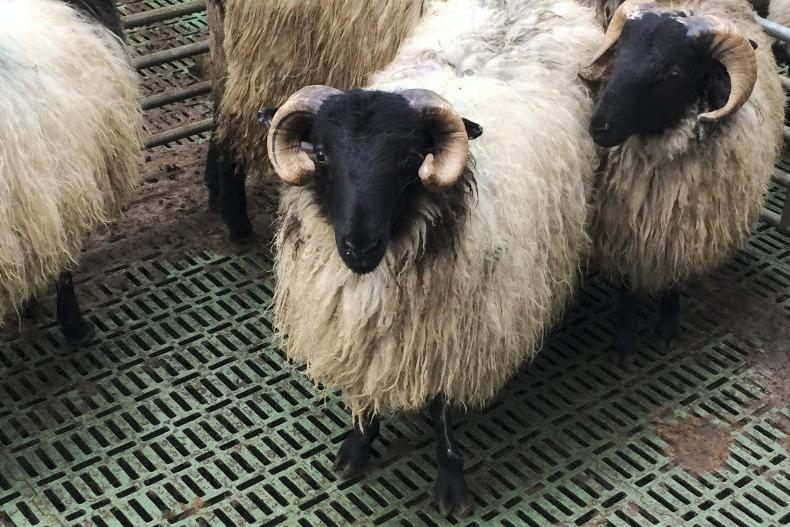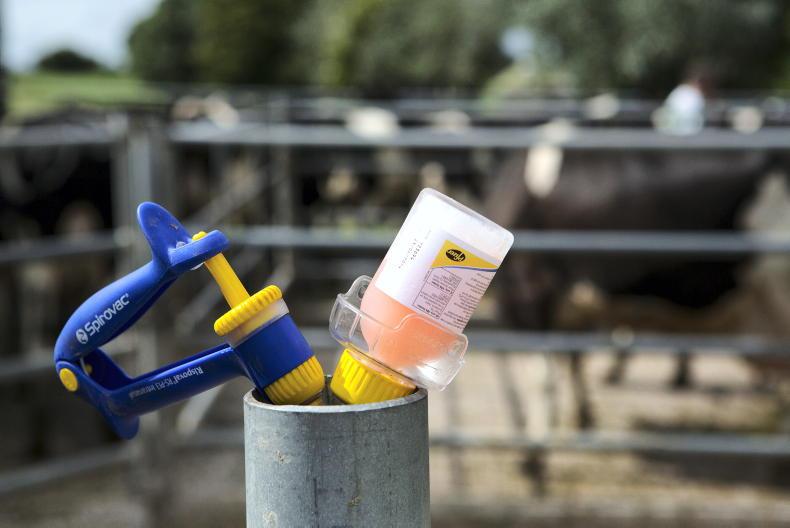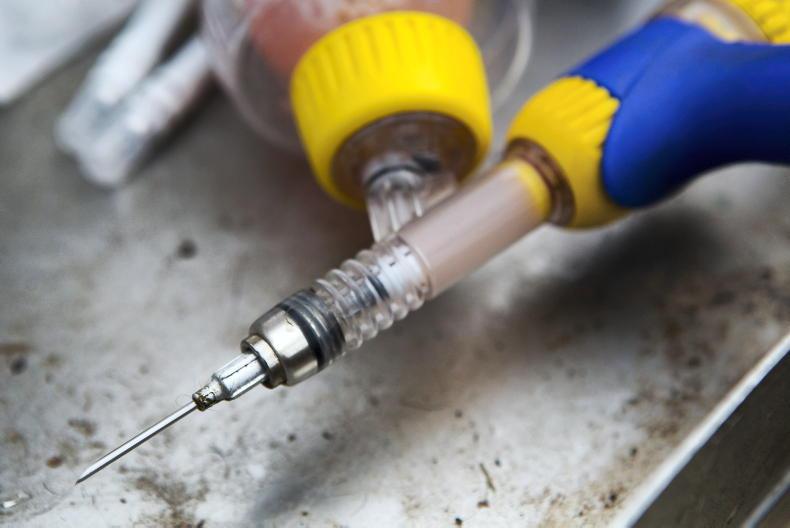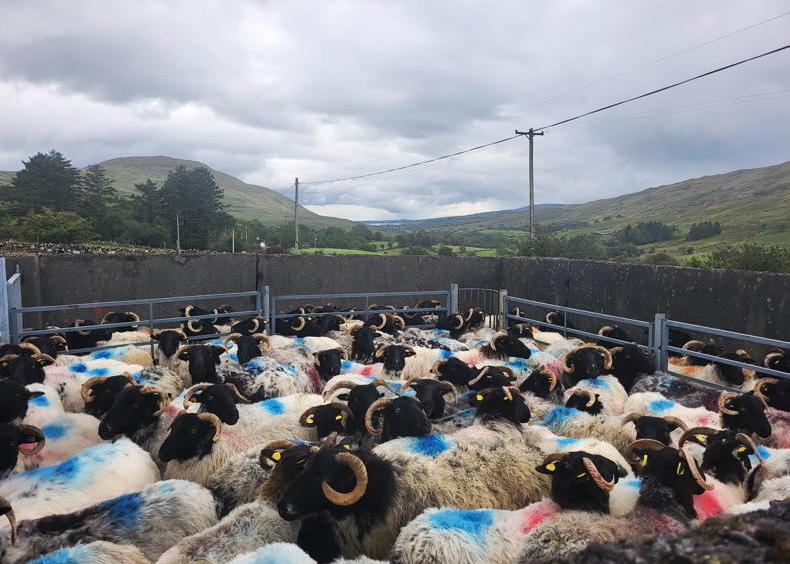When liver fluke and tick-related diseases are excluded, eye issues in sheep are probably the next greatest ailment faced by farmers in the northwest of the country.
This opinion was delivered by Donegal Teagasc adviser Seamus Campbell at Thursday night’s Teagasc National Hill Sheep Conference. Seamus was delivering a presentation which was co-authored by veterinary practitioner based in Donegal Gerald Roarty.
Seamus outlined that there are five common eye issues seen on Irish farms and that problems are often encountered most at this time of year due to harsh weather conditions and management practices.
1) Pink eye / keratoconjunctivitis
The veterinary term for the eye ailment commonly known as pink eye is keratoconjunctivitis. Its causes include any source of trauma that allows a bacterial source to set up an infection, with common contributors listed as dust from poor-quality forage and occasionally irritation from driving snow or gales.
In terms of the bacteria responsible, mycoplasma conjunctivae is considered to be the primary cause, but several other bacterial species are also suggested as causative agents, including chlamydia organisms which are linked with abortion.
Early signs
Early signs of issues are increased tear stains in the area under the eye, a partially closed eye and, in more advanced cases, a reddening of the tissue around the eyeball (conjunctiva), which is normally a salmon pink colour.
The disease can progress from mild conjunctivitis to ulceration and permanent loss of the eye with temporary or permanent blindness.
Affected animals will appear dull or depressed due to the discomfort in the eye and depending on the severity of the disease, blindness will be apparent with ewes very unsettled.
Seamus says it is a huge problem in open hills, as sheep can walk for miles when in a distressed state and end up walking into drains, etc.
Pink eye can spread quickly in a flock and Seamus advises that the starting point is to isolate any cases as soon as they are identified and treat accordingly.
He recommends that farmers retain affected animals outdoors in a sheltered, safe field if possible rather than housing.
Treatment options
Treatment is complicated by the fact it is difficult to deliver the necessary concentrations required to kill the bacteria in the tear fluid for a sufficient period of time.
Seamus outlined four treatment routes: intramuscular injection, subconjunctival injection, topical cream or ointment.
The advice where administering a subconjunctival injection or topical cream or ointment is to wear fresh gloves for each animal handled as the fluid secreted from the eye of affected sheep is deemed highly contagious.
In administering creams or ointments, the lower eyelid should be everted and a steady flow of ointment instilled, taking care to avoid touching the tube of the eye or surrounding tissue to avoid contamination.
The recommendation is to apply ointment at least three times daily, which is not readily practical in a lot of flocks.
Another limitation highlighted with this treatment route is that many licensed ointments contain cloxacillin, which is not active against mycoplasma species.
A long-acting injectable oxytetracycline antibiotic may result in a clinical cure, but not always eliminate the bacteria, meaning that the disease may reappear in these animals or they may become carriers.
In answering a question as to whether ewes will recover in their own time, Gerald Roarty says that this is not a welfare-friendly approach. He says that many ewes will recover on their own, but that some ewes will never recover.
In the worst-affected cases, the disease may progress to active ulceration which can cause corneal rupture and loss of the eye or eyes.
In such cases, surgical intervention may be required, along with pain relief on welfare grounds.
Seamus outlines that a vaccine has been developed in New Zealand for administering to cattle, adding that research there has shown that where animals recover without treatment, they will not succumb to the disease thereafter.
2) Silage eye / anterior uveitis
The next common ailment discussed at this time of year is what is commonly termed as silage eye, also known by its veterinary name anterior uveitis. The bacteria which causes the condition is typically listeria monocytogenes.
This bacteria is found everywhere in nature, but it is most commonly found in poor-quality silage which has preserved badly, is contaminated with soil or has been open for a few days.
The less-acidic pH of spoiled silage is said to enhance multiplication of listeria monocytogenes, with outbreaks typically occurring 10 days after feeding poor-quality silage.

A ewe suffering from temporary blindness in one eye, which is likely due to silage eye.
Listeria can also cause listeriosis in sheep, a disease which affects the brain or can be the causative agent of abortion or scour in sheep.
The issue is most frequently found in sheep which are eating round bale silage and burrowing their head in through the silage.
Symptoms are similar to pink eye, including a watery discharge from eyes, a wet stained area under the eye and visible irritation. There will also be a light blue, white or grey coloured cloudiness or scum on the cornea of the eye, leading to blindness.
Treatment options
Seamus outlines that treatment options are similar to pink eye, including topical antibiotics in ointment, aerosol or injectable form.
He says that a combination of 1cc of a steroid such as dexamethasone, along with 1cc of oxytetracycline, administered into the sub-conjunctiva is more successful than antibiotics administered on their own.
Gerald highlights that treatment with steroids can be tricky on two fronts – you are working with products not licensed and have to be used under the cascade system (used on welfare grounds), while steroids should generally not be administered to pregnant sheep.
However, Gerald says that, in his experience, there is usually not an issue with administering a low volume of 1cc.
Listeria is a zoonotic-causing disease in humans, which can be very serious and fatal. As such, it is important to take appropriate measures and practice high levels of hygiene, including disinfection.
The third and last infectious eye condition listed was periorbital eczema. This disease occurs when the area around the eye is damaged allowing for entry of staphylococcus aureus bacteria to enter.
It can result in the area around the eyes becoming swollen, with lesions forming and the sight sometimes becoming limited. It can also spread to other areas of the face.
Seamus says it occurs mainly where there is not enough room at troughs or ring feeders, with trauma occurring where sheep are rushing to eat and bang heads together or by damage by sheep forcing themselves in to eat at feed barriers or creep feeders and hitting their head.
Treatment options
The disease responds well to broad-spectrum intramuscular antibiotics, such as amoxicillin or oxytetracycline.
Sheep with both eyes affected may have their vision impaired and therefore require preferential treatment, along with segregation from the main flock.
The fourth eye issue discussed was entropion, a non-infectious eye condition caused by inward rolling of the eyelid and typically seen in newborn lambs. The eyelashes traumatise or damage the cornea or outer part of the eyelid. It causes significant irritation and can lead to infection and ulceration.
Similar to pink eye or silage eye, the irritation will lead to increased tear production and a watery discharge.
It is a genetic issue and lambs sired by particular rams can be affected, as can lambs born to ewes which suffered from the condition.
Treatment options
The treatment route depends on the severity of entropion. In simple cases, the lower eyelid can be everted by simply rolling down the skin under the lower eyelid. This may need to be repeated on a number of occasions.
Administering a topical antibiotic to the cornea will prevent secondary infection and will also act as a lubricant.
If the above steps do not solve the issue, then administering 0.5ml of an antibiotic, such as penicillin, into the lower eyelid will help. This is a tricky proposition and the lamb will need to be securely held.
It is advised to use a 21-gauge, 15mm needle inserted into the lower eyelid, staying parallel to and approximately 1cm to 2cm below the lower eyelid.
Administering the antibiotic will generate a mild inflammatory response, which will keep the lower eyelid firm while also addressing any infection.
Some farmers also find that if they pinch the bottom of the eyelid with their thumb and index finger, it will also generate a reaction.
Seamus advises that an injection of a non-steroidal inflammatory is indicated for pain under veterinary supervision.
Surgical intervention or the use of sutures or metal clips can also be used in serious cases. Where the condition is prevalent, then the breeding programme should be reviewed.
The final eye condition discussed is relevant to horned sheep and is ingrown horns. The condition occurs where the growth of the horn turns inward in the direction of the eye region.
It is most apparent in aged rams, but is also common now in intensively finished male lambs and sometimes in aged ewes.
The tip of a sheep’s horn is described as lacking innervation and communication with the frontal sinus, meaning it can be safely trimmed back without requiring anaesthesia.
Read more
Spring liver fluke treatment options
When liver fluke and tick-related diseases are excluded, eye issues in sheep are probably the next greatest ailment faced by farmers in the northwest of the country.
This opinion was delivered by Donegal Teagasc adviser Seamus Campbell at Thursday night’s Teagasc National Hill Sheep Conference. Seamus was delivering a presentation which was co-authored by veterinary practitioner based in Donegal Gerald Roarty.
Seamus outlined that there are five common eye issues seen on Irish farms and that problems are often encountered most at this time of year due to harsh weather conditions and management practices.
1) Pink eye / keratoconjunctivitis
The veterinary term for the eye ailment commonly known as pink eye is keratoconjunctivitis. Its causes include any source of trauma that allows a bacterial source to set up an infection, with common contributors listed as dust from poor-quality forage and occasionally irritation from driving snow or gales.
In terms of the bacteria responsible, mycoplasma conjunctivae is considered to be the primary cause, but several other bacterial species are also suggested as causative agents, including chlamydia organisms which are linked with abortion.
Early signs
Early signs of issues are increased tear stains in the area under the eye, a partially closed eye and, in more advanced cases, a reddening of the tissue around the eyeball (conjunctiva), which is normally a salmon pink colour.
The disease can progress from mild conjunctivitis to ulceration and permanent loss of the eye with temporary or permanent blindness.
Affected animals will appear dull or depressed due to the discomfort in the eye and depending on the severity of the disease, blindness will be apparent with ewes very unsettled.
Seamus says it is a huge problem in open hills, as sheep can walk for miles when in a distressed state and end up walking into drains, etc.
Pink eye can spread quickly in a flock and Seamus advises that the starting point is to isolate any cases as soon as they are identified and treat accordingly.
He recommends that farmers retain affected animals outdoors in a sheltered, safe field if possible rather than housing.
Treatment options
Treatment is complicated by the fact it is difficult to deliver the necessary concentrations required to kill the bacteria in the tear fluid for a sufficient period of time.
Seamus outlined four treatment routes: intramuscular injection, subconjunctival injection, topical cream or ointment.
The advice where administering a subconjunctival injection or topical cream or ointment is to wear fresh gloves for each animal handled as the fluid secreted from the eye of affected sheep is deemed highly contagious.
In administering creams or ointments, the lower eyelid should be everted and a steady flow of ointment instilled, taking care to avoid touching the tube of the eye or surrounding tissue to avoid contamination.
The recommendation is to apply ointment at least three times daily, which is not readily practical in a lot of flocks.
Another limitation highlighted with this treatment route is that many licensed ointments contain cloxacillin, which is not active against mycoplasma species.
A long-acting injectable oxytetracycline antibiotic may result in a clinical cure, but not always eliminate the bacteria, meaning that the disease may reappear in these animals or they may become carriers.
In answering a question as to whether ewes will recover in their own time, Gerald Roarty says that this is not a welfare-friendly approach. He says that many ewes will recover on their own, but that some ewes will never recover.
In the worst-affected cases, the disease may progress to active ulceration which can cause corneal rupture and loss of the eye or eyes.
In such cases, surgical intervention may be required, along with pain relief on welfare grounds.
Seamus outlines that a vaccine has been developed in New Zealand for administering to cattle, adding that research there has shown that where animals recover without treatment, they will not succumb to the disease thereafter.
2) Silage eye / anterior uveitis
The next common ailment discussed at this time of year is what is commonly termed as silage eye, also known by its veterinary name anterior uveitis. The bacteria which causes the condition is typically listeria monocytogenes.
This bacteria is found everywhere in nature, but it is most commonly found in poor-quality silage which has preserved badly, is contaminated with soil or has been open for a few days.
The less-acidic pH of spoiled silage is said to enhance multiplication of listeria monocytogenes, with outbreaks typically occurring 10 days after feeding poor-quality silage.

A ewe suffering from temporary blindness in one eye, which is likely due to silage eye.
Listeria can also cause listeriosis in sheep, a disease which affects the brain or can be the causative agent of abortion or scour in sheep.
The issue is most frequently found in sheep which are eating round bale silage and burrowing their head in through the silage.
Symptoms are similar to pink eye, including a watery discharge from eyes, a wet stained area under the eye and visible irritation. There will also be a light blue, white or grey coloured cloudiness or scum on the cornea of the eye, leading to blindness.
Treatment options
Seamus outlines that treatment options are similar to pink eye, including topical antibiotics in ointment, aerosol or injectable form.
He says that a combination of 1cc of a steroid such as dexamethasone, along with 1cc of oxytetracycline, administered into the sub-conjunctiva is more successful than antibiotics administered on their own.
Gerald highlights that treatment with steroids can be tricky on two fronts – you are working with products not licensed and have to be used under the cascade system (used on welfare grounds), while steroids should generally not be administered to pregnant sheep.
However, Gerald says that, in his experience, there is usually not an issue with administering a low volume of 1cc.
Listeria is a zoonotic-causing disease in humans, which can be very serious and fatal. As such, it is important to take appropriate measures and practice high levels of hygiene, including disinfection.
The third and last infectious eye condition listed was periorbital eczema. This disease occurs when the area around the eye is damaged allowing for entry of staphylococcus aureus bacteria to enter.
It can result in the area around the eyes becoming swollen, with lesions forming and the sight sometimes becoming limited. It can also spread to other areas of the face.
Seamus says it occurs mainly where there is not enough room at troughs or ring feeders, with trauma occurring where sheep are rushing to eat and bang heads together or by damage by sheep forcing themselves in to eat at feed barriers or creep feeders and hitting their head.
Treatment options
The disease responds well to broad-spectrum intramuscular antibiotics, such as amoxicillin or oxytetracycline.
Sheep with both eyes affected may have their vision impaired and therefore require preferential treatment, along with segregation from the main flock.
The fourth eye issue discussed was entropion, a non-infectious eye condition caused by inward rolling of the eyelid and typically seen in newborn lambs. The eyelashes traumatise or damage the cornea or outer part of the eyelid. It causes significant irritation and can lead to infection and ulceration.
Similar to pink eye or silage eye, the irritation will lead to increased tear production and a watery discharge.
It is a genetic issue and lambs sired by particular rams can be affected, as can lambs born to ewes which suffered from the condition.
Treatment options
The treatment route depends on the severity of entropion. In simple cases, the lower eyelid can be everted by simply rolling down the skin under the lower eyelid. This may need to be repeated on a number of occasions.
Administering a topical antibiotic to the cornea will prevent secondary infection and will also act as a lubricant.
If the above steps do not solve the issue, then administering 0.5ml of an antibiotic, such as penicillin, into the lower eyelid will help. This is a tricky proposition and the lamb will need to be securely held.
It is advised to use a 21-gauge, 15mm needle inserted into the lower eyelid, staying parallel to and approximately 1cm to 2cm below the lower eyelid.
Administering the antibiotic will generate a mild inflammatory response, which will keep the lower eyelid firm while also addressing any infection.
Some farmers also find that if they pinch the bottom of the eyelid with their thumb and index finger, it will also generate a reaction.
Seamus advises that an injection of a non-steroidal inflammatory is indicated for pain under veterinary supervision.
Surgical intervention or the use of sutures or metal clips can also be used in serious cases. Where the condition is prevalent, then the breeding programme should be reviewed.
The final eye condition discussed is relevant to horned sheep and is ingrown horns. The condition occurs where the growth of the horn turns inward in the direction of the eye region.
It is most apparent in aged rams, but is also common now in intensively finished male lambs and sometimes in aged ewes.
The tip of a sheep’s horn is described as lacking innervation and communication with the frontal sinus, meaning it can be safely trimmed back without requiring anaesthesia.
Read more
Spring liver fluke treatment options










SHARING OPTIONS